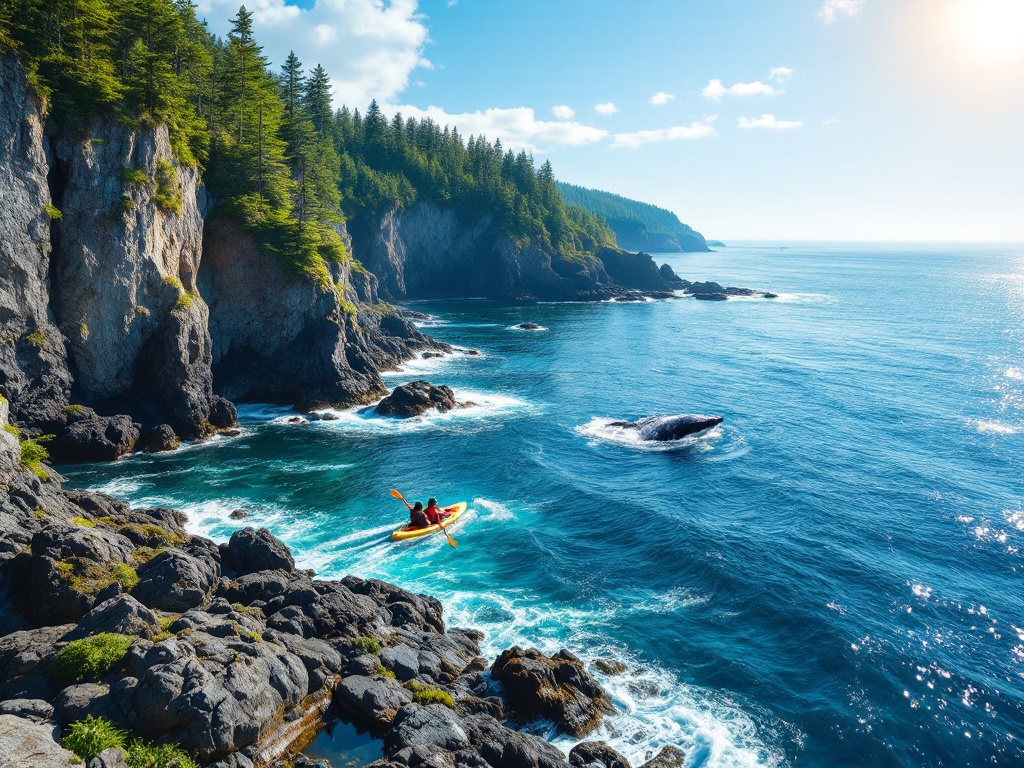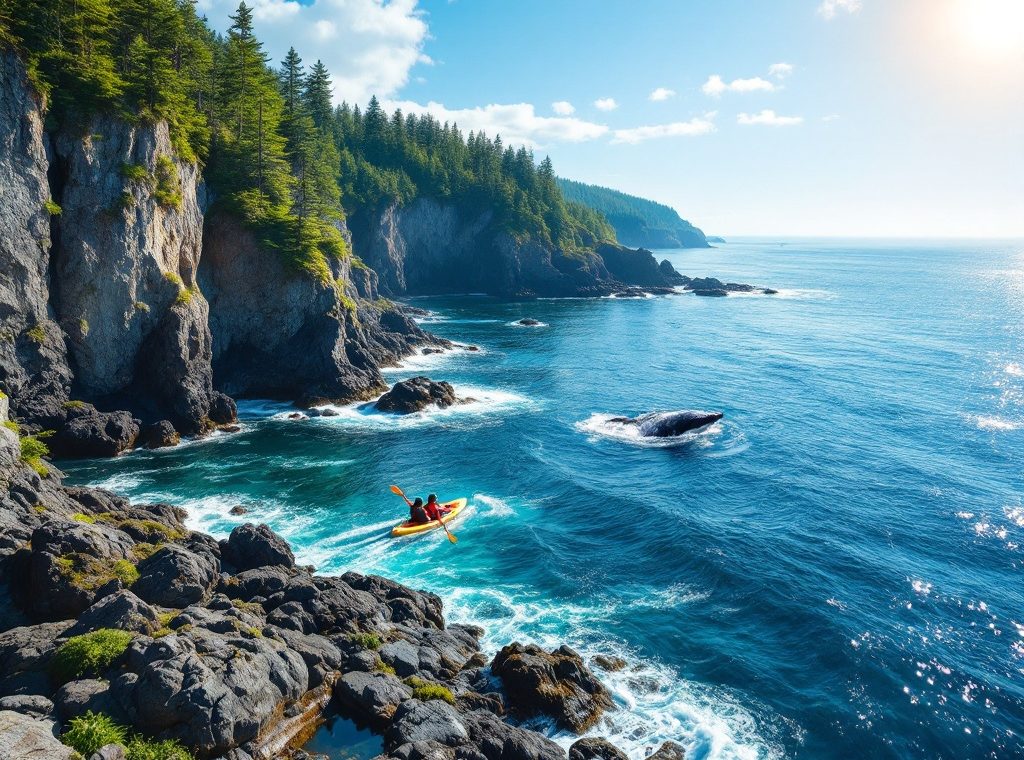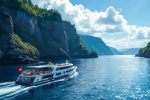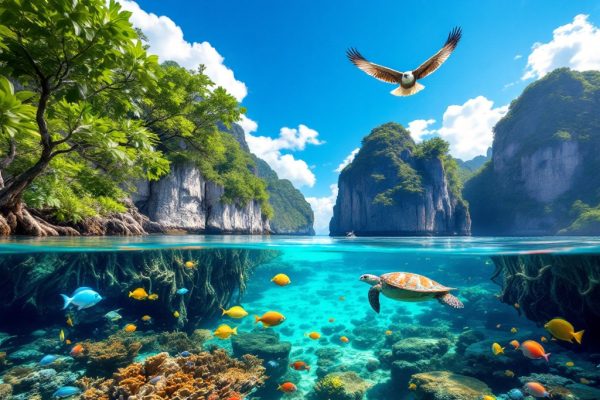Bay of Fundy: A Natural Wonder at the Canadian Coast
Witness the world’s highest tides at Canada’s Bay of Fundy! Twice daily, 53-foot tides reshape the coastline, revealing unique rock formations and a vibrant ecosystem teeming with marine life, including the endangered North Atlantic right whale. Explore dramatic cliffs, kayak amidst “flowerpot” rocks, and embark on thrilling whale watching tours. Discover this natural wonder – plan your Bay of Fundy adventure today!
Important information

- The Bay of Fundy, located between New Brunswick and Nova Scotia, Canada, is known for the world’s highest tides, reaching 53 feet.
- The extreme tides create a unique ecosystem, supporting diverse marine life, including the endangered North Atlantic right whale.
- The tides also sculpt dramatic rock formations, like the Hopewell Rocks, and offer opportunities for kayaking and exploring the sea floor at low tide.
- Burntcoat Head holds the Guinness World Record for the highest tides.
- The Bay of Fundy is a UNESCO Biosphere Reserve and a potential source of tidal power, presenting both conservation opportunities and challenges.
Bay of Fundy: A Natural Wonder at the Canadian Coast
Bay of Fundy: A Natural Wonder at the Canadian Coast Located on Canada’s east coast, between New Brunswick and Nova Scotia, the Bay of Fundy is a natural wonder renowned for its dramatic tides. Twice daily, the water level rises and falls by as much as 53 feet, creating a dynamic environment. This supports diverse ecosystems teeming with marine and coastal life. These powerful tides also sculpt the bay’s breathtaking geological formations. This offers visitors a unique opportunity to explore remarkable features and discover the region’s rich biodiversity.
Where is the Bay of Fundy Located?
Nestled between New Brunswick and Nova Scotia on Canada’s Atlantic coast, the Bay of Fundy stretches 94 miles inland, a remarkable natural wonder.
What Makes the Bay of Fundy a Natural Wonder?
The Bay of Fundy, home to the world’s highest tides, experiences a dramatic 16-meter (53-foot) rise and fall of water twice daily. This unique tidal phenomenon creates diverse ecosystems and breathtaking landscapes, captivating visitors with impressive rock formations and towering cliffs. The bay provides a crucial habitat for marine life and birds, making it a vital and fascinating natural wonder.
The Phenomenal Tidal Range of the Bay of Fundy
The Bay of Fundy is renowned for having the world’s highest tides, reaching an astounding 16 meters (53 feet). This dramatic tidal range is due to the bay’s unique funnel-like shape and its resonance with the ocean’s natural rhythms. As the tide surges into the narrowing bay, the water is amplified, much like liquid in a funnel. Furthermore, the time it takes for a tidal wave to travel to the bay’s head and back perfectly matches the tidal period, creating a resonant effect that further magnifies the tides. This phenomenon exposes vast stretches of ocean floor twice daily, creating a dynamic intertidal zone teeming with diverse marine life and supporting a rich ecosystem.
Understanding the Highest Tides in the World
The Bay of Fundy, home to the world’s highest tides, experiences a dramatic rise and fall of water exceeding 52 feet (16 meters). This incredible tidal variation creates a dynamic ecosystem and shapes the surrounding landscape. The bay’s unique funnel-like structure amplifies the tides, causing rapid shifts in water levels. This makes it a true natural wonder.
The Impact of Tidal Changes on the Landscape
The Bay of Fundy is known for having the world’s most extreme tides, which dramatically reshape its coastline twice a day. As the tide goes out, it reveals hidden geological formations and diverse habitats, creating a dynamic ecosystem. The incoming tide carves the bay’s unique cliffs and rocks. Powerful currents distribute sediments and nutrients, influencing where marine life thrives.
Geological Features and Scenic Landscapes
The Bay of Fundy is renowned for its breathtaking coastal scenery, featuring dramatic cliffs and unusual rock formations sculpted by the bay’s powerful tides and erosion. The Hopewell Rocks, with their distinctive flowerpot shapes, stand as a prime example of this tidal force. Fundy National Park further reveals a rich geological history, with its towering cliffs narrating a captivating tale of time and tides.
Exploring Craggy Cliffs and Dramatic Cliffs
The Bay of Fundy is known for its dramatic cliffs, sculpted by the world’s highest tides, offering breathtaking views. The constant tidal erosion creates a unique landscape of caves, sea stacks, and rugged coastlines, perfect for exploration and photography. The sheer power of the tides is truly awe-inspiring.
Notable Sites: Burntcoat Head and Hopewell Rocks
Nova Scotia’s Burntcoat Head is famous for having the world’s highest tides, a distinction confirmed by the Guinness World Record.
New Brunswick’s Hopewell Rocks offer a different coastal experience. The relentless tide has carved striking “flowerpot” rock formations. At low tide, the seabed is perfect for exploring on foot. High tide invites kayaking adventures amidst these impressive natural sculptures.
Rich Biodiversity and Unique Ecosystems
The Bay of Fundy, renowned for its dramatic tides, supports a variety of unique habitats. As the tide goes out, a vibrant intertidal zone emerges, teeming with life such as clams and crabs. Adjacent salt marshes provide crucial nesting grounds for birds. The nutrient-rich waters support diverse fish populations, attracting larger marine animals, including the endangered North Atlantic right whale. The bay’s ecosystem is also vital for migratory birds, offering essential food and rest stops during their long journeys.
Marine Life: North Atlantic Right Whale and More
The Bay of Fundy’s nutrient-rich waters attract a remarkable array of marine wildlife. Humpback, minke, and the endangered North Atlantic right whale migrate through its depths. They share this rich ecosystem with seals, porpoises, and numerous fish species. Above, a variety of seabirds contribute to the bay’s vibrant biodiversity. This unique tidal environment supports a truly remarkable web of life.
Top Wildlife Species in and around the Bay of Fundy
The Bay of Fundy is a vibrant hub of marine life. Humpback, minke, and fin whales grace its waters, alongside the endangered North Atlantic right whale. Harbor porpoises and seals add to the lively mix, playing amongst the numerous fish species that teem below. Overhead, migratory shorebirds and seabirds are a frequent spectacle, completing this rich and dynamic ecosystem.
Ways to Explore the Bay of Fundy
Discover the wonders of the Bay of Fundy. Explore the scenic coastline by kayak or embark on a thrilling whale watching adventure. Hike picturesque trails and witness the dramatic low tide revealing the ocean floor, teeming with life in its tide pools. Capture breathtaking sunsets and diverse wildlife, a paradise for birdwatching and photography enthusiasts. Indulge in fresh, local seafood in charming coastal towns and delve into the area’s rich maritime history. Unique rock formations enhance the bay’s beauty, home to whales, seabirds, and seals. While kayaking and whale watching tours offer incredible up-close encounters, exploring the expansive tidal flats at low tide is truly unforgettable.
Activities
- Kayaking along the scenic coastline.
- Whale watching tours for up-close encounters.
- Hiking picturesque trails.
- Exploring the tidal flats at low tide.
Highlights
- Breathtaking sunsets.
- Diverse wildlife, including whales, seabirds, and seals.
- Unique rock formations.
- Fresh, local seafood in coastal towns.
- Rich maritime history.
Whale Watching Tours and Sea Kayaking Adventures
Embark on an unforgettable whale watching adventure, encountering majestic humpbacks, fin whales, and minkes. You might even spot the elusive North Atlantic right whale. For a different kind of thrill, explore the coastline by sea kayak, discovering hidden caves and remarkable rock formations sculpted by the tides. Keep an eye out for wildlife encounters with seals, porpoises, and diverse seabirds.
Hiking the Fundy Footpath and Coastal Trails
Explore the stunning Bay of Fundy via the challenging, 41-kilometer Fundy Footpath. This rugged wilderness trek offers breathtaking vistas for experienced hikers. For a less strenuous adventure, wander the coastal trails, showcasing dramatic cliffs and unique rock formations. Discover diverse ecosystems teeming with wildlife, including whales, seals, and vibrant tide pools at low tide. Enjoy kayaking and whale watching tours for a different perspective of this remarkable bay.
Conservation Efforts and UNESCO Recognition
The Bay of Fundy, a designated UNESCO Biosphere Reserve and partially a Ramsar site for its vital wetlands, is undeniably a special place with a globally significant ecosystem. These recognitions highlight the crucial role of conservation efforts. However, balancing the protection of this natural wonder with the development of tidal power presents a complex challenge.
UNESCO World Heritage Site and Biosphere Reserve
Designated a UNESCO Biosphere Reserve, the Bay of Fundy boasts rich biodiversity and a unique intertidal ecosystem. It is not a World Heritage Site.
Protecting the Bay: Conservation and Tidal Power Generation
The Bay of Fundy is a critical conservation area with diverse ecosystems and remarkable tides. These natural wonders require ongoing protection. Several initiatives safeguard this unique environment, especially its biodiversity. The bay is a haven for the endangered North Atlantic right whale and many other marine animals and birds. Beyond its ecological importance, the Bay of Fundy offers a unique opportunity for sustainable tidal power energy. Ongoing research explores how to harness this potential while minimizing environmental impact. The challenge is balancing our energy needs with preserving this natural wonder for future generations.
Ecological Importance
The Bay of Fundy is a critical conservation area, boasting diverse ecosystems and remarkable tides. It provides a haven for various marine animals and birds, including the endangered North Atlantic right whale.
Sustainable Energy Potential
The Bay of Fundy presents a unique opportunity for sustainable energy through tidal power. Ongoing research focuses on harnessing this potential while minimizing the environmental impact, addressing the key challenge of balancing energy needs with preservation.













